|
April 27, 2003: A Few Indiana Towns
|
|
April 27, 2003: A Few Indiana Towns
|
|
|
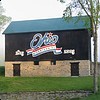 I ended Saturday with the knowledge that the next day would be dry and
sunny and that I had no pressing plans. I decided that I
"needed" to drive somewhere and I recalled a recent conversation
with my parents about the town of Columbus, Indiana. They have visited the
town several times and remember it as filled with interesting buildings
with widely different architectural styles. I knew I had been there a few
times in the early 70s but not in the daylight and not with an inclination
to study the town's structures. A quick check showed it to be about a
hundred miles away and another place of some reputation, Metamora, could
easily be included in the route. I went to bed with the next day's plans
roughly set.
I ended Saturday with the knowledge that the next day would be dry and
sunny and that I had no pressing plans. I decided that I
"needed" to drive somewhere and I recalled a recent conversation
with my parents about the town of Columbus, Indiana. They have visited the
town several times and remember it as filled with interesting buildings
with widely different architectural styles. I knew I had been there a few
times in the early 70s but not in the daylight and not with an inclination
to study the town's structures. A quick check showed it to be about a
hundred miles away and another place of some reputation, Metamora, could
easily be included in the route. I went to bed with the next day's plans
roughly set.
So why, one might wonder, does the first picture from an Indiana trip show a barn with a red, white, & blue Ohio on its side? A little background is that there is one such barn in every Ohio county as part of the bicentennial. I've seen only a few of the barns and not the one in my home county, Hamilton. The Hamilton County Bicentennial Barn is but seven miles from the state line and near the path from my home to many Indiana spots, including Columbus. This seemed a good opportunity to make a visit. Although the day promised to be a warm one, it started off cool and, along the Great Miami River, foggy. I was growing concerned that I would be unable to see the barn in the fog but there was an opening in the gray just where I needed it. The temperature, however, did not break. It was 36° F at the barn. |
|
|


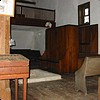 This church, on US 52 between New Trenton and Cedar Grove, was a nice
surprise. Still intact and at its original location after more than 190
years. Its solid brick construction helped it survive and made it a
valuable and rather rare building in 1812. The building was undoubtedly
called on for duty beyond the purely religious and openings through which
guns could be fired hint at what one of those duties must have been. There
isn't a bad seat in the house. Both floor have pews facing the raised
pulpit from three sides so the preacher can see each worshiper and vise
versa. Oddly, the building has spent more time serving historians than
parishioners. By 1840, it was no longer in use as a church due to growth
in neighboring areas.
This church, on US 52 between New Trenton and Cedar Grove, was a nice
surprise. Still intact and at its original location after more than 190
years. Its solid brick construction helped it survive and made it a
valuable and rather rare building in 1812. The building was undoubtedly
called on for duty beyond the purely religious and openings through which
guns could be fired hint at what one of those duties must have been. There
isn't a bad seat in the house. Both floor have pews facing the raised
pulpit from three sides so the preacher can see each worshiper and vise
versa. Oddly, the building has spent more time serving historians than
parishioners. By 1840, it was no longer in use as a church due to growth
in neighboring areas.
|
|
|

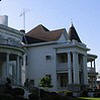
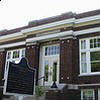
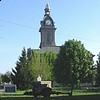 Brookville is the southern tip of the 5000 acre Brookville Lake so many
folks associate the name with recreation rather that history. It is the
seat of Franklin County with an impressive court house and quite a few
other older buildings. Like in so many mid-sized towns, the older
buildings of Brookville show the results of a wide range of care. Most,
"official" buildings are maintained rather well as are many
private residences. But, even though not every historic building in
Brookville is a showpiece, I did not see any that could be called
decrepit. Something that is not true of every town. In the last picture,
you can see that I did put the car in levitation mode in an effort to
get an aerial view of the houses but I couldn't get above the trees.
Brookville is the southern tip of the 5000 acre Brookville Lake so many
folks associate the name with recreation rather that history. It is the
seat of Franklin County with an impressive court house and quite a few
other older buildings. Like in so many mid-sized towns, the older
buildings of Brookville show the results of a wide range of care. Most,
"official" buildings are maintained rather well as are many
private residences. But, even though not every historic building in
Brookville is a showpiece, I did not see any that could be called
decrepit. Something that is not true of every town. In the last picture,
you can see that I did put the car in levitation mode in an effort to
get an aerial view of the houses but I couldn't get above the trees.
|
|
|

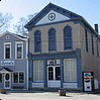
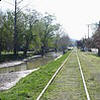
 Metamora is
the first place I knew I would be visiting so I sort of targeted it for
breakfast. This was accomplished at the Duck Creek Palace. This is one of
those tourist towns with gift shops every few feet and a tendency toward
"cuteness" but there are enough bits of the town's real past
showing through to make it worthwhile. The third picture hints at a couple
of different points in that past. The town of Metamora was born in 1838
more or less in conjunction with the
Whitewater Canal. The two main components of a canal,
water channel and tow path, are shown in the picture. The era of canals
ended with the coming of railroads and sometimes a little recycling
occurred. Here the tow path serves as a bed for rails. The last picture is
of the Duck Creek Aqueduct. It only requires a little thought to realize
that, even though both are made of water, some special attention is needed
where a canal has to cross a stream. The solution is a bridge like
aqueduct that carries the water of the canal over the water of the stream.
Once, there were more than a hundred aqueducts in the US canal system but
only this one remains.
Metamora is
the first place I knew I would be visiting so I sort of targeted it for
breakfast. This was accomplished at the Duck Creek Palace. This is one of
those tourist towns with gift shops every few feet and a tendency toward
"cuteness" but there are enough bits of the town's real past
showing through to make it worthwhile. The third picture hints at a couple
of different points in that past. The town of Metamora was born in 1838
more or less in conjunction with the
Whitewater Canal. The two main components of a canal,
water channel and tow path, are shown in the picture. The era of canals
ended with the coming of railroads and sometimes a little recycling
occurred. Here the tow path serves as a bed for rails. The last picture is
of the Duck Creek Aqueduct. It only requires a little thought to realize
that, even though both are made of water, some special attention is needed
where a canal has to cross a stream. The solution is a bridge like
aqueduct that carries the water of the canal over the water of the stream.
Once, there were more than a hundred aqueducts in the US canal system but
only this one remains.
|
|
|


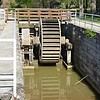
 This quite active mid-1800s flour mill incorporates some additional canal
related recycling. Without the need for boats passing through the locks,
they became attractive places for mounting water wheels and that is what
happened at Whitewater Lock #25. Today the mill, which also serves as a
museum, was staffed by Sidney & Jeanetta. Sidney is the miller and
told me the wheel can generate about 15 horsepower but that by the time it
passes through the various belts and rollers, which she maintains, it's
down to 2 HP or less. Electric motor backup exists and is sometimes used
but the majority of grinding is done with direct water power. Both corn
meal and wheat flour are produced and are available for purchase. The
pause for breakfast and the stroll around Metamora gave the sun and
temperature time to rise. The top went down and I left the canal in 67
degree sunlight.
This quite active mid-1800s flour mill incorporates some additional canal
related recycling. Without the need for boats passing through the locks,
they became attractive places for mounting water wheels and that is what
happened at Whitewater Lock #25. Today the mill, which also serves as a
museum, was staffed by Sidney & Jeanetta. Sidney is the miller and
told me the wheel can generate about 15 horsepower but that by the time it
passes through the various belts and rollers, which she maintains, it's
down to 2 HP or less. Electric motor backup exists and is sometimes used
but the majority of grinding is done with direct water power. Both corn
meal and wheat flour are produced and are available for purchase. The
pause for breakfast and the stroll around Metamora gave the sun and
temperature time to rise. The top went down and I left the canal in 67
degree sunlight.
|
|
|
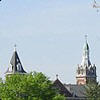
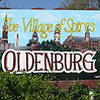
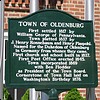 As you travel south on route 229, when the village of
Oldenburg
first comes into view any question you might have about why it is called
"The Village of Spires" is gone. The name, which might seem like
an attempt at a witty way to describe the town, is actually the name of
its founders home in Germany. The town is "olden", with most
homes built in the 1800s, and German, with "strassa" signs
marking its thoroughfares. It is the
Sisters of St. Francis who
have given Oldenburg much of its history and charm.
As you travel south on route 229, when the village of
Oldenburg
first comes into view any question you might have about why it is called
"The Village of Spires" is gone. The name, which might seem like
an attempt at a witty way to describe the town, is actually the name of
its founders home in Germany. The town is "olden", with most
homes built in the 1800s, and German, with "strassa" signs
marking its thoroughfares. It is the
Sisters of St. Francis who
have given Oldenburg much of its history and charm.
|
|
|
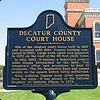
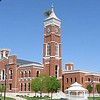 South of Oldenburg, I turned right before actually entering Batesville and
headed west on SR 46. About half way between Batesville and Columbus lies
the town of Greensburg with its unique rooftop garden. In 1870, when the
Decatur County Courthouse was just 9 years old, a tree was spotted growing
atop its tower. At one time, there were four trees on the roof of the 110
foot tower but one was removed, in the interest of safety, in 1882 and two
on the tower's south side reportedly died from heat. The advertising value
of the tree was soon apparent and the court house tree has long been
cultivated by county government for its tourist drawing ability.
South of Oldenburg, I turned right before actually entering Batesville and
headed west on SR 46. About half way between Batesville and Columbus lies
the town of Greensburg with its unique rooftop garden. In 1870, when the
Decatur County Courthouse was just 9 years old, a tree was spotted growing
atop its tower. At one time, there were four trees on the roof of the 110
foot tower but one was removed, in the interest of safety, in 1882 and two
on the tower's south side reportedly died from heat. The advertising value
of the tree was soon apparent and the court house tree has long been
cultivated by county government for its tourist drawing ability.
|
|
|

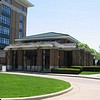
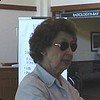 After a couple of exploratory passes through downtown, I stopped at the
Columbus Visitor Center with the idea of picking up a
map. I was surprised to learn that they offered a two hour bus tour,
disappointed to hear that the only Sunday tour had departed an hour
before, then pleased when the girl verified that the bus had yet to make
its halfway stop back at the center. I could get in on the last half.
The pictures are of the North Christian Church, the Columbus Regional
Hospital, and our guide, Ruth, in the hospital lobby.
After a couple of exploratory passes through downtown, I stopped at the
Columbus Visitor Center with the idea of picking up a
map. I was surprised to learn that they offered a two hour bus tour,
disappointed to hear that the only Sunday tour had departed an hour
before, then pleased when the girl verified that the bus had yet to make
its halfway stop back at the center. I could get in on the last half.
The pictures are of the North Christian Church, the Columbus Regional
Hospital, and our guide, Ruth, in the hospital lobby.
It was quickly apparent that Columbus's reputation as a architectural center was justified and the tour gave me a quick overview of why. The short answer is that Columbus is home to Cummins Diesel and Cummins has a standing offer to pay the architect fees for any public building that uses an approved major architect. One result is that the American Institute of Architects ranks Columbus sixth in the US for architectural innovation and design with the top five being the metropolises of Chicago, New York, San Francisco, Washington, D.C., and Boston. There are nearly 13 million people living in those cities with 572,000 in the smallest. The population of Columbus is 39,000. |
|
|
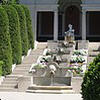
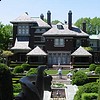
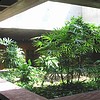
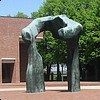 Following the bus tour, I walked to a couple of attractions adjacent to
the Visitor Center. Right next to the center is the Cleo Rogers Memorial
Library with a Henry Moore sculpture, "Large Arch", in front.
I. M. Pei, one of the few architects whose name I even recognize, did
the library. The library seemed much less striking than many other
buildings around town although it did have a nice sense of openness. The
green area and sky light is on the second floor/balcony.
Following the bus tour, I walked to a couple of attractions adjacent to
the Visitor Center. Right next to the center is the Cleo Rogers Memorial
Library with a Henry Moore sculpture, "Large Arch", in front.
I. M. Pei, one of the few architects whose name I even recognize, did
the library. The library seemed much less striking than many other
buildings around town although it did have a nice sense of openness. The
green area and sky light is on the second floor/balcony.
Just beyond the library is the Irwin House & Gardens. Neither are listed on the architectural tour maps but the gardens are quite impressive. The gardens are only open on weekends which somewhat offsets the fact that the interior of most buildings can only be seen on week days. The name Irwin is tightly connected with the city of Columbus and even with Cummins Diesel. With much hard work, intelligent investments, and a reputation for honesty, Joseph I. Irwin established Irwin's Bank in 1871. This was the beginnings of the bank that provided financial backing for Cummins Diesel, was influential in moving the company that became Arvin Industries to Columbus, and has generally been a strong financial presence in the city. |
|
|

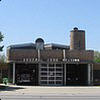
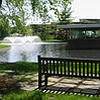
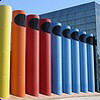
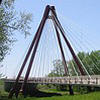 Before leaving Columbus, I drove to some interesting locations that were
either part of the part of the tour I had missed or which I just wanted to
see closer. The first is the courthouse and the second the art deco Fire
Station No. 1. The pond is at one of the Cummins buildings and what looks
like a colorful pipe organ are vents for the Ameritech Switching Station.
In the picture, the Second Street Bridge looks like it might be a foot
bridge across a small stream. It is actually four lanes wide and crosses
the White River.
Before leaving Columbus, I drove to some interesting locations that were
either part of the part of the tour I had missed or which I just wanted to
see closer. The first is the courthouse and the second the art deco Fire
Station No. 1. The pond is at one of the Cummins buildings and what looks
like a colorful pipe organ are vents for the Ameritech Switching Station.
In the picture, the Second Street Bridge looks like it might be a foot
bridge across a small stream. It is actually four lanes wide and crosses
the White River.
|
|
|
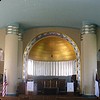

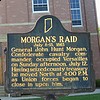
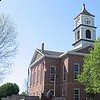 I headed south east on SR 7 then picked up US 50. By coincidence, I had
picked up "The longest Raid", Lester Horwitz's book on Morgan's
ride through Indiana and Ohio, on Saturday. I had started reading the book
at breakfast and would continue during dinner so it is only right that,
like Morgan, I stop at the courthouse in Versailles. From near the
courthouse, the unusual church spire can be seen and I drove over to take
a look. The church it sat on was equally unusual and I remembered scraps
about a church in Versailles as I walked around it. The building is the
Tyson Temple United Methodist Church and the parsonage is right next door;
actually connected by a tunnel, I learned later. My roaming was noticed by
Reverend Mike Dixon and he offered to give me a look inside.
I headed south east on SR 7 then picked up US 50. By coincidence, I had
picked up "The longest Raid", Lester Horwitz's book on Morgan's
ride through Indiana and Ohio, on Saturday. I had started reading the book
at breakfast and would continue during dinner so it is only right that,
like Morgan, I stop at the courthouse in Versailles. From near the
courthouse, the unusual church spire can be seen and I drove over to take
a look. The church it sat on was equally unusual and I remembered scraps
about a church in Versailles as I walked around it. The building is the
Tyson Temple United Methodist Church and the parsonage is right next door;
actually connected by a tunnel, I learned later. My roaming was noticed by
Reverend Mike Dixon and he offered to give me a look inside.
The temple is the 1937 gift of Jim Tyson and it is called a temple because, just as when the first temple was built in Jerusalem, no hammers were heard during its construction; there are no nails in the building. There is symbolic purpose to every aspect of the building and Tyson's personal touches and choices are everywhere. The ceiling mimics the sky and is illuminated by reflected light to aid the illusion. The temple was built in memory of Jim Tyson's mother and it is the sky on the night she died that appears on the ceiling. Tyson's money came from his early involvement in Walgreen's Drug Stores and his gifts to his home town include 18,000 shares of Walgreen's stock. That gift continues to fund village needs and projects. There are many differences (including the fact that Versailles has never had a Walgreen's' store) but visiting the two towns on the same day makes it impossible to completely avoid comparing W. G. Irwin (Joseph's son), Clessie Cummins, and Columbus with Jim Tyson, Charles Walgreen, and Versailles. |
|
|
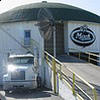 Just west of Aurora a large round building appeared on the side of US 50.
My first thought, that it must be a barn, proved wrong but what I found is
no less strange. Round, white, and immense, the structure is a two story
concrete block building where giant Mack trucks are serviced. In size, it
is closer to the an old locomotive round house than to any barn.
Just west of Aurora a large round building appeared on the side of US 50.
My first thought, that it must be a barn, proved wrong but what I found is
no less strange. Round, white, and immense, the structure is a two story
concrete block building where giant Mack trucks are serviced. In size, it
is closer to the an old locomotive round house than to any barn.
|
|
|
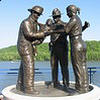
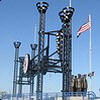
 Plenty of light remained when I reached
Lawrenceburg
and I took advantage of it to check out the riverside monument created as
part of the city's 2002 bicentennial celebration. In the six years since
Argosy Casino ( now Hollywood Casino) opened on the Ohio River at
Lawrenceburg, the town of 4,500 or so has made out like a - well, like a
one armed bandit. In the last year before the boat, the town's annual
budget was $3.3 million. Now they can afford a $2.5 million monument.
Called "War Memorial to the Common Man", the monument features
bronze statues of military and civilian service personnel, 12 foot clocks
facing both river and land and there is a 30 bell carillon. A few people
walked along the path that crosses the monument and a couple sat on the
wall near the cluster of bronze representatives from all five military
branches. After a short conversation, when I started to leave, the man
mentioned that, in a few minutes, the bells would be ringing and the
statue turning. According to posted information, the carillon would play
the tune for each branch as its statue rotated to the front. I stayed and
was only slightly disappointed that, for some unknown reason, the statues
didn't move. The three of us enjoyed the perfect weather and what amounted
to a private carillon concert. Then it was time for Ohio and home.
Plenty of light remained when I reached
Lawrenceburg
and I took advantage of it to check out the riverside monument created as
part of the city's 2002 bicentennial celebration. In the six years since
Argosy Casino ( now Hollywood Casino) opened on the Ohio River at
Lawrenceburg, the town of 4,500 or so has made out like a - well, like a
one armed bandit. In the last year before the boat, the town's annual
budget was $3.3 million. Now they can afford a $2.5 million monument.
Called "War Memorial to the Common Man", the monument features
bronze statues of military and civilian service personnel, 12 foot clocks
facing both river and land and there is a 30 bell carillon. A few people
walked along the path that crosses the monument and a couple sat on the
wall near the cluster of bronze representatives from all five military
branches. After a short conversation, when I started to leave, the man
mentioned that, in a few minutes, the bells would be ringing and the
statue turning. According to posted information, the carillon would play
the tune for each branch as its statue rotated to the front. I stayed and
was only slightly disappointed that, for some unknown reason, the statues
didn't move. The three of us enjoyed the perfect weather and what amounted
to a private carillon concert. Then it was time for Ohio and home.
|
|
|